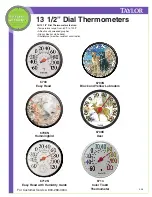
2. °C/°F
This device can show the measured temperature in °C or in °F
If the °C or the °F symbol (F) is blinking, you can change the measuring unit
by using the up button (4) and/or the down button (6).
3. High Alarm Level (H.AL) On/Off
You can set a High Alarm Level if you want the Temppointer 9 attends you
when the measured temperature is above the H.AL temperature you’ve set.
If the H.AL symbol (D) is blinking, and “on” or “off” is on the screen, you can
set the H.AL function on or off by using the up button (4) and/or the down
button (6).
4. High Alarm Level (H.AL)
You can choose the maximum allowed temperature. If the measured temper-
ature is above this temperature and de H.AL function is ON (see step 3), the
Temppointer 9 attends you by making a sound and a blinking H.AL symbol
(D). Temperatures can set between -50 to 800°C (-58 to 1472°F).
If the H.AL symbol (D) is blinking, and a value is on the screen, you can
change the High Alarm Level by using the up button (4) and/or the down
button (6).
5. Low Alarm Level (L.AL) On/Off
You can set a Low Alarm Level if you want the Temppointer 9 attends you
when the measured temperature is under the L.AL temperature you’ve set.
If the L.AL symbol (E) is blinking, and “on” or “off” is on the screen, you can
set the L.AL function on or off by using the up button (4) and/or the down
button (6).
6. Low Alarm Level (L.AL)
You can choose the minimum allowed temperature. If the measured temper-
ature is under this temperature and de L.AL function is ON (see step 5), the
Temppointer 9 attends you by making a sound and a blinking L.AL symbol
(E). Temperatures can set between -50 to 800°C (-58 to 1472°F).
If the L.AL symbol (E) is blinking, and a value is on the screen, you can
change the Low Alarm Level by using the up button (4) and/or the down
button (6).
BATTERY REPLACEMENT
When the battery power gets to low, the Low power symbol (G) will appear on the
display. Replacement of the 2x AAA batteries is required.
Open the battery cover (12), then take out the batteries and replace them with
new ones. (Pay attention to the batteries polarity.) Put the batterycover back in
place.
MAINTENANCE
Repairs or services are not covered in this manual and should only be carried out
by qualified trained technicians.
Periodically, wipe the body with a dry cloth. Do not use abrasives or solvents on
this instrument.
For service, use only manufacturer’s specified parts.
























